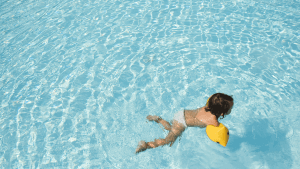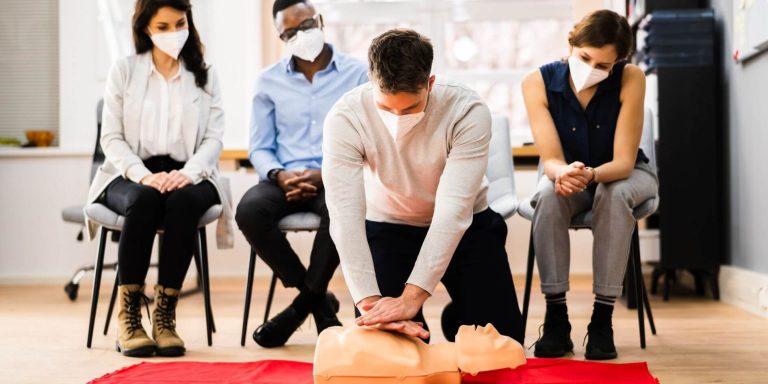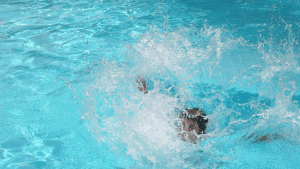Drowning In Babies and Children

Drowning is the biggest preventable killer of children under 5.
How many babies drown each year?
25 children aged 0-4 years drowned in Australia in 2020-21. This is a 108% increase to the year before. This may have been due o the COVID lockdowns.
36% of these deaths were boys.
Most of thes accidents happened by children falling into backyard swimming pools or lakes and dams. 5 of these children drowned in the bath or spa, likely in their home or a friends.
We recommend when attending a pool party or a party at a house with a pool, that you agree with everyone there to keep an eye on your own child. Trying to watch all the children could end in disaster, especially the younger 0-4 year old age group.
For every 1 child that dies from drowning, another 7 receive hospitalisation. Almost 1/4 will suffer a brain injury due to lack of oxygen resulting in disabilities for life
One of the reasons that this young age group is at risk, is because they can lift themselves up and climb. Some children of that age, have absolutely no fear at all. Always make sure that there are no large plant pots or chairs near the pool gates, as young resourceful children will drag them over an use them to stand on.

It is also worth remembering that older siblings that can easily reach a pool gate, may accidentally let the younger children into the pool area.
Children between the age of 0-4 years often also have little or no swimming ability , even if they have had lessons, they may noyt be able to get themselves out of any situation.
Infant First Aid
Children can drown in just a few cm of water . They only need to have their mouth and nose covered for them to drown. They do not need to be completely submerged.
Children can drown silently and quickly. Babies have what is called a diving reflex?
What this means is that if a toddler falls in the water, they have an natural instinct to hold their breath, open their eyes and sink. They won’t fight for the surface; they don’t splash and scream. This is how children can submerge underwater without anyone noticing.
Irreversible brain damage occurs in just a few minutes. It doesn’t take long for this to occur. Our bodies carry oxygen in our cells, and with drowing these pockets of oxygen are depleted very quickly, making rescue breaths more important than in any other emergency scenario.
Near-drowning most often occurs when no lifeguard or medical professional is present. You may attempt to rescue the person from the water, but only if it’s safe for you to do so.
There are too many stories of parents jumping into the water unprepared and before calling for help, getting themselves in trouble too.
Tips for helping someone who is drowning include:
- Use life rings or throw ropes
- Only enter the water if you have the swimming skills to do so
- If the person has near-drowned in cold water, remove their wet clothes & keep warm
If you find your child in the water and you don’t know how long they have been under, ALWAYS get them checked by a doctor. Your child may seem ok at first but there is a condition known as dry drowning.
This is where the water does not actually get into the lungs, however breathing in the water can make your child’s vocal cords close up. This makes it hard for them to breathe. These symptoms would mostly be obvious right away.
Secondary drowning is when water gets into the lungs and causes irritation in the lining. Fluid can build up, and as a result the lungs can’t function properly and the oxygen supply is severely compromised. Symptoms would be present staright away and would get worse over time.
If you pull an unconscious child from the water, start CPR immediately. We no longer check for a pulse and if a child is unconscious after being submerged in water, we can assume they are not breathing. If CPR on a baby is not necessary, it will become obvious very quickly. CPR would be very uncomfortable and the baby would respond very quickly.
Rescue breaths are very important in a drowning or near-drowning due to the oxygen level in the blood being very poor.

What Can You Do?
- Actively Supervise – never take your eyes off a child that is in or near water
- Restrict Access - make sure pool gates are locked
- Water Awareness – Attend swimming lessons with your baby as soon as possible
- Learn to resuscitate – Book yourself into a specific baby first aid course and learn the life saving techniques that could one day help your little one or someone elses.
Baby First Aid Course
Our baby first aid courses are available in person in your home and online.
We run classes in your home with groups of 2, 4 or up to 10 in Sydney & Melbourne and you can book in 3 easy steps!
- Pick your class
- Follow the prompts to purchase
- We will contact you within 24 hours to lock in your date of choic

